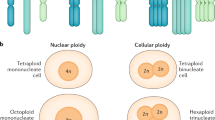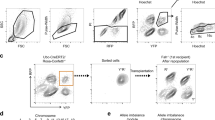Abstract
ALTHOUGH it has generally been assumed that the nuclei of the parenchymal cells of mammalian liver have ploidies in the ratio of 2N : 4N : 8N : 16N … (ref. 1), contradictory reports have recently appeared. One described the existence in C3H mice of nuclei with ploidies of 3N, 6N and 12N, the first amounting to as much as 25–50 per cent of the nuclei during the first 2 weeks of life2. The other claimed that there is, in human liver, a continuum of nuclear DNA contents and volumes, and that individual classes of nuclei are not present3. The reasons for the discrepancies between these results and the generally accepted theory are not known, but one possibility is that the methods of preparation and measurement of the material may produce systematic errors. Both the studies were carried out on sections of fixed tissues with micro-spectrophotometric methods that were less than optimal. During the course of the investigation of the relationship of cell size to cell ploidy4, measurements of nuclear size and ploidy have been carried out with intact, single parenchymal cells. The results obtained again confirm the existence of clearly defined classes of parenchymal cell nuclei.
This is a preview of subscription content, access via your institution
Access options
Subscribe to this journal
Receive 51 print issues and online access
$199.00 per year
only $3.90 per issue
Buy this article
- Purchase on SpringerLink
- Instant access to full article PDF
Prices may be subject to local taxes which are calculated during checkout
Similar content being viewed by others
References
Helweg-Larsen, H. F., Acta Path. Microbiol. Scand. Suppl., 92, 1 (1952).
Pogo, A. O., Cordero Funes, J. R., and Mordoh, J., Exp. Cell Res., 21, 482 (1960).
Fautrez, J., and Laquerriere, R., Exp. Cell Res., 13, 403 (1957).
Epstein, C. J., Proc. U.S. Nat. Acad. Sci., 57, 327 (1967).
Rappoport, C., and Howze, G. B., Proc. Soc. Exp. Biol. and Med., 121, 1010 (1966).
Leuchtenberger, C., in General Cytochemical Methods (edit. by Danielli, J. F.), 1, 220 (Academic Press, Inc., New York, 1958).
Jacobj, W., Arch. Entw. Mechan., 106, 124 (1925).
Swartz, F. J., Chromosoma, 8, 53 (1956).
Doljanski, F., Intern. Rev. Cytol., 10, 217 (1960).
Swift, H., Physiol. Zool., 23, 169 (1950).
Author information
Authors and Affiliations
Rights and permissions
About this article
Cite this article
EPSTEIN, C., GATENS, E. Nuclear Ploidy in Mammalian Parenchymal Liver Cells. Nature 214, 1050–1051 (1967). https://doi.org/10.1038/2141050a0
Received:
Published:
Issue Date:
DOI: https://doi.org/10.1038/2141050a0
This article is cited by
-
AAV Vectors, Insertional Mutagenesis, and Cancer
Molecular Therapy (2007)
-
Transplanted bone marrow regenerates liver by cell fusion
Nature (2003)
-
Stable reprogrammed heterokaryons form spontaneously in Purkinje neurons after bone marrow transplant
Nature Cell Biology (2003)
-
Targeted mutation in the Fas gene causes hyperplasia in peripheral lymphoid organs and liver
Nature Genetics (1995)
-
Mice with DNA repair gene (ERCC-1) deficiency have elevated levels of p53, liver nuclear abnormalities and die before weaning
Nature Genetics (1993)



